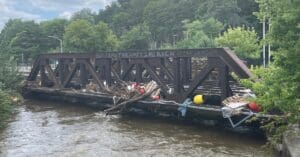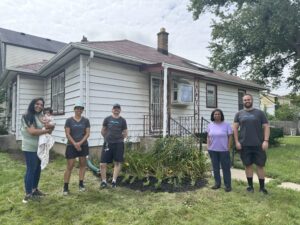On August 9th and 10th, Milwaukee County endured a 1,000-year storm, a 24-hour event with just a 1 in 1,000 chance of happening in any given year. The county experienced an average of 9.18 inches of rain, with some areas seeing up to 14 inches of rain over the 24-hour period.
Many residents suffered sewage backup, flooded basements, lost power, and car damage. Some even lost their homes. Thankfully, the City of Milwaukee sprang into action, sending out fleets of vehicles to clear debris and extending large trash pick-up times. In response to reduced federal support from programs like FEMA, many Milwaukee residents pitched in to help clear standing water out of basements, remove flood-damaged belongings, and clean out clogged storm drains.

The storm brought green infrastructure and stormwater management to the forefront of public conversations. While residents lost belongings, and even some homes, the aftermath would have been far worse without large-scale municipal green infrastructure throughout the city.
A local story from Susan Bence with WUWM highlighted the presence of two existing stormwater basins, the north and east basins, and the continued construction of the west basin. Residents interviewed for the story noted that they felt like this storm was less destructive than the 2008 and 2010 floods, but more work is yet to be done.
The combined effects of municipal and residential green infrastructure will help to offset future flooding events by slowing down water as it falls. This helps reduce street flooding from clogged drains, rapids-like conditions in channelized riverways, and water rushing toward building foundations.
Green infrastructure works
The 30th Street Industrial Corridor used to bustle with manufacturing, but disinvestment over the years left many vacant lots and abandoned buildings—most of which consist of concrete covered surfaces. These impervious surfaces, where water cannot return to the ground, combined with the historical landscape of wetlands and meandering creeks and rivers within the Corridor, make it a vulnerable location for flooding. This is why most of Clean Wisconsin’s green infrastructure installation work is focused on the north side of the city.
To best understand the impacts of our work, we turn to the residents who have received green infrastructure installations, attended workshops, and helped spread knowledge to their neighbors.

Antrea Taylor of Milwaukee’s Lincoln Creek neighborhood is one of many outstanding examples of how invested community members can make a noticeable difference, block by block. Antrea first interacted with our program at an outreach event last Fall, “I really had no prior knowledge of rain barrels or rain gardens before” she said, “but Ethan handed me a pamphlet, and I thought it sounded great.” For Antrea and her family, gardening had always been an interest but felt inaccessible before having a rain barrel installed. “Now,” shared Antrea, “we just walk outside and there’s our barrel of rainwater ready to be recycled in our garden. It saves money and it feels good to be reusing it.”
Living just up the street from Lincoln Creek, Antrea’s family experienced standing water in their basement and lost many personal belongings to the storm in August. “We just feel blessed that we didn’t lose more, some of our neighbors are still clearing out items and starting to rebuild” noted Antrea, “and we were so excited to come out the next day and find our garden still standing amongst the debris.”
Our team installed a native planting at the Taylor home at the beginning of July, so the plants are still establishing their roots and acclimating to the new soil. While the storm raged, Antrea could see some of her tall blazing star stalks standing above the water, but the rest were submerged under flood waters. “It was so awesome to see the water management in action and see it do what it was intended to,” Antrea shared as we inspected how the soil had settled into the ground after the flood waters subsided.
Another resident, Sandra Beamon, resides in the Rufus King neighborhood and experienced basement flooding. Sandra helps keep watch for litter in the alley behind her home and on her street corner. Keeping the storm drain clear is something that she does often, as she knows the importance of allowing flood water to drain. At the time of the storm, Sandra only had a rain barrel installed. Installation of her rain garden was scheduled for a week and a half later.

“You know that big storm we just had, you see the evidence right there,” she pointed to her rain barrel, “it was filled to the top, and that would’ve been in my house.” Sandra felt passionately that those 50-gallons her barrel captured mattered greatly; “could have been worse than what I got right now.” Being able to see first-hand and interact with the rainwater is something that Sandra appreciated: “you guys come and do the garden using the same water…to water it. That’s what it was all about wasn’t it…I can tell you, it works great.”
Beyond serving a functional water management purpose, Antrea talked about how much joy it has brought her: “I’m not just in and out of the house anymore. I’m pausing, taking time to watch the bugs come through my garden and appreciating those smaller details.”
Several homes along Antrea’s street now have rain barrels thanks to her advocacy and outreach. She loves to people-watch and kept seeing a trend of hustle and bustle among neighbors, “I think we all need to slow down more and find ways to connect with all ages. This improves quality of life too and I want to share that solitude with others, and if it’s not for them, that’s okay, but I still share what I can just in case.” Antrea and Sandra both appreciate the different aspects in which the installations have improved their day-to-day life. “I love the colors,” said Sandra, “good work being done in the community.”
Where Do We Go from Here?
Over the last 10 years of the program, 94 rain gardens and 905 rain barrels were installed throughout the north side. By the end of September, our green infrastructure program will have installed over 50 rain barrels and nearly 30 rain gardens this season alone. This is an added capacity of over 2,500-gallons of water collected by rain barrels, and assuming an average garden installation size of 30-square feet and 4.4-gallons of holding capacity per square foot, an additional 4,620-gallons for the rain gardens. Now, imagine that much capacity added to each neighborhood with the addition of the north basin, which is planned to hold 31-million gallons of water—that’s a lot of stormwater diverted from basements and causing sewer overflows!

The Milwaukee Metropolitan Sewerage District (MMSD) is still committed to green infrastructure on a residential and municipal scale as a practice of climate resiliency outlined in their 2035 Vision. If you want to be a part of the vision, you can install a rain barrel, a rain garden or native vegetation planting, and learn more ways to be involved in sharing resources within your community and neighboring communities.
Throughout the year, MMSD hosts workshops in collaboration with local partners like Clean Wisconsin that explore different green infrastructure installations. You can attend these events, like the Big Plant Tree Workshops on the 14th and 18th of October. Follow along with the Area of Concern Community Advisory Committee (cacmke.org) to attend community focused environmental events in Milwaukee and beyond.

